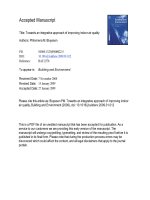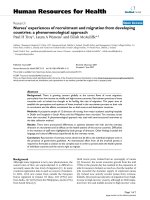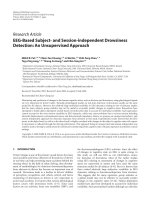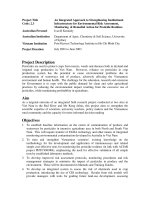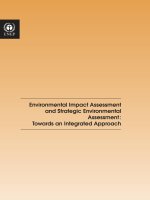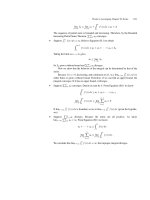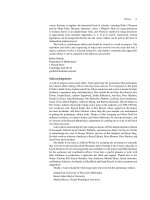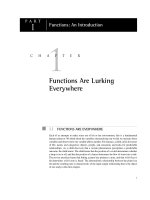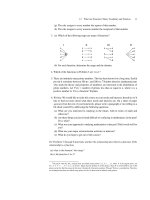Environmental Impact Assessment and Strategic Environmental Assessment: Towards an Integrated Approach pdf
Bạn đang xem bản rút gọn của tài liệu. Xem và tải ngay bản đầy đủ của tài liệu tại đây (748.43 KB, 163 trang )
Environmental Impact Assessment
and Strategic Environmental
Assessment:
Towards an Integrated Approach
DTI-0514-PA
www.unep.org
United Nations Environment Programme
P.O. Box 30552 Nairobi, Kenya
Tel: (254 2) 621234
Fax: (254 2) 623927
E-mail:
web: www.unep.org
Environmental Impact Assessment and Strategic Environmental Assessment: Towards an Integrated Approach
Economics and Trade Branch
Division of Technology, Industry, and Economics
United Nations Environment Programme
11-13, chemin des Anémones
CH-1219 Geneva, Switzerland
Tel: +41 22 917 82 43
Fax: +41 22 917 80 76
Web: www.unep.ch/etu
40369_envir_couv 30.03.2004 12:01 Page 1
By
Hussein Abaza
DTIE-ETB, UNEP
Ron Bisset
BMT Cordah Limited
Barry Sadler
UNEP Adviser
Advisory
This report deals with a fast moving field and the subject matter may become
quickly dated. Readers are advised to check the main sources cited for updates
and new materials. However, UNEP considers the fundamentals of EIA and SEA good
practice as discussed here to be more durable and likely to remain relevant
in the immediate future.
Environmental Impact Assessment
and Strategic Environmental
Assessment:
Towards an Integrated Approach
Copyright 2004 UNEP
This publication may be reproduced in whole or in part and in any form for educational or
non-profit purposes without special permission from the copyright holder, provided
acknowledgement of the source is made. UNEP would appreciate receiving a copy of any
publication that uses this publication as a source.
No use of this publication may be made for resale or for any other commercial purpose
whatsoever without prior permission in writing from UNEP.
First edition 2004
The designations employed and the presentation of the material in this publication do not
imply the expression of any opinion whatsoever on the part of the United Nations
Environment Programme concerning the legal status of any country, territory, city or area
or of its authorities, or concerning delimitation of its frontiers or boundaries. Moreover,
the views expressed do not necessarily represent the decision or the stated policy of the
United Nations Environment Programme, nor does citing of trade names or commercial
processes constitute endorsement.
ISBN: 92-807-2429-0
Printed on recycled paper
THE UNITED NATIONS ENVIRONMENT PROGRAMME
The United Nations Environment Programme (UNEP) is the overall coordinating
environmental organization of the United Nations system. Its mission is to provide
leadership and encourage partnerships in caring for the environment by inspiring,
informing and enabling nations and people to improve their quality of life without
compromising that of future generations.
UNEP’s Economics and Trade Branch (ETB) is one of the branches of the Division of
Technology, Industry and Economics (DTIE). Its mission is to enhance capacities of countries,
particularly developing countries and countries with economies in transition, and to
integrate environmental considerations in development planning and macroeconomic
policies, including trade policies. The work programme of the Branch consists of three
main components: economics, trade and financial services. The Economics component of
the programme focuses on enhancing the capacities of countries, particularly developing
countries and countries with economies in transition, to develop and implement assessment
tools and economic instruments.
UNEP’s work on assessments includes the further development and promotion of
environmental impact assessment as an effective tool to integrate environmental
considerations at the project, programme and policy levels to achieve sustainable
development.
For more information, please contact:
Hussein Abaza
Chief, Economics and Trade Branch
Division of Technology, Industry and Economics
United Nations Environment Programme
11-13 chemin des Anémones
CH-1219 Châtelaine/Geneva
Tel: +41 (0)22 917 8243 or 917 8179
Fax: +41 (0)22 917 8076
email:
Internet: />The United
Nations
Environment
Programme
iii
TABLE OF CONTENTS
Foreword ix
Acknowledgements xi
Abbreviations and Acronyms xiii
Chapter 1: Introduction and Objectives 1
1.1 Purpose of the document 1
1.2 Relationship to UNEP mandate and other initiatives 1
1.3 Need and rationale for an integrated assessment 3
1.4 EIA and SEA as steps towards integrated assessment 6
1.5 Effectiveness of EIA 7
1.6 Effectiveness of SEA 8
1.7 Target audience for this document 10
Government staff 10
Staff of multi- and bilateral agencies 10
Private sector personnel 11
References 12
Chapter 2: EIA Systems – Legal and Institutional Arrangements 15
2.1
Context and challenges for developing countries and countries in transition
15
2.2 Elements of EIA systems 17
EIA arrangements _ trends and status 18
EIA implementation _ factors and capabilities 20
2.3 Approaches for making the EIA process effective 24
Self-directed assessment 25
EIA process administration 25
Guidance on EIA implementation 27
Public involvement and consultation 28
2.4 Other institutional aspects and challenges 29
Avoiding overlap and duplication between national and international EIA
procedures and requirements 29
EIA implications of international environmental law and policy 31
Multilateral EIA transboundary and participatory regimes 32
Costs and benefits of EIA 33
References 34
Chapter 3: Principles and Elements of EIA Good Practice 39
3.1 Introduction 39
3.2 Aims/objectives of EIA 40
3.3 General and specific principles of EIA application 41
3.4 EIA practice step by step 44
3.5 Screening and preliminary EIA studies 44
3.6 Scoping and preparation of terms of reference 47
3.7 EIA work and impact studies 49
Establishing an environmental baseline 50
Review of alternatives 51
Environment/project interactions 51
Table of Contents
v
Social/environmental interactions 52
Associated developments and secondary/cumulative effects 52
Coping with uncertainty and determining risk 53
Evaluation of impact significance 53
3.8 Mitigation and the environmental management plan 55
3.9 The EIA report 56
3.10 Review of EIA report 57
3.11 Impact management and monitoring 59
Elements of impact management 59
Elements of monitoring 60
3.12
Final note on the importance of EIA follow-up and evaluation of performance
61
References 63
Chapter 4: Public Involvement and Consultation 65
4.1 Introduction 65
4.2 Background to use of public involvement and consultation in EIA/SEA 66
4.3 Aims and objectives of public involvement and consultation 66
4.4 Recent legal and institutional changes affecting role of public involvement
and consultation 66
4.5 Public involvement in SEA (differences from EIA) 67
4.6 Role of stakeholders in public involvement and consultation 69
4.7 Types of public involvement and consultation 70
4.8 Improving practice in stakeholder involvement in EIA/SEA 71
Scoping 77
Appraisal and EIA/SEA report preparation 77
Implementation 77
Evaluation 78
4.9 Costs 78
4.10 Future trends 79
Use of mediation in conflict resolution 79
Traditional knowledge 81
References 83
Chapter 5: Strategic Environmental Assessment 85
5.1 Context and challenges 85
5.2 Background 86
What is SEA? 86
Why is SEA important? 86
How does SEA compare to or differ from EIA? 87
5.3 SEA trends and current “take-up” 87
5.4 SEA arrangements and procedures 88
5.5 SEA aims, principles and elements of approach 92
5.6
Scope of applications and examples of SEA of policy, plans and programmes
94
SEA of policy 95
SEA of sector plans and programmes 97
SEA of spatial plans 99
5.7 Guidance on SEA methodology and good practice 101
References 109
Table of Contents
vi
Chapter 6 : Towards Integrative Approaches to Impact Assessment
and Planning 113
6.1 Introduction 113
6.2 Horizontal integration of impacts in EIA and EIA- type studies at
the project level 115
6.3 Integration of project sustainability and wider sustainability issues 117
6.4 Integration of distribution impacts in comparison of options 118
6.5 Integrative methods and tools 120
6.6 Links between EIA/SEA and sustainability analyses 122
6.7 Integration and sustainability issues for Strategic Environmental
Assessment (SEA) 125
6.8 Vertical linking of EIA and Environmental Management Systems 128
6.9 Integration of tools for application in poverty reduction strategies and
programmes 129
6.10 Merging assessment with planning for sustainable development 131
6.11 Future directions 131
6.12 Last words 132
References 134
Annex 1: Advice on Assessing Social, Health and Economic Impacts in EIAS 137
Social impacts 137
Health impacts 140
Economic impacts 141
Fiscal impacts 144
Risk and uncertainty 145
Hazardous events 145
Impact probabilities 146
Annex 2: Tiering EIA and SEA 147
Boxes
Box 1:1 UNEP's work on integrated assessment of trade liberalization policies 2
Box 1:2 Links between socio-economic and environmental impacts 6
Box 1:3 Recent reviews of EIA/SEA effectiveness 9
Box 2:1 Some recent trends in EIA capacity development 17
Box 2:2 Key elements in the design of EIA systems 18
Box 2:3 EIA legal developments in transitional countries 20
Box 2:4 Development of the EIA system in Nepal 22
Box 2:5 Preparation of EIA regulations and guidelines in Swaziland and Zambia 22
Box 2:6 How public involvement can support better EIA implementation –
an example from Mexico 23
Box 2:7 Guiding principles of due process and EIA administration 24
Box 2:8 Harmonization of EIA requirements and procedures between the World
Bank and newly independent states of the former Soviet Union 30
Box 2:9 International environmental agreements relevant to EIA 32
Box 3:1 Proposed EIA framework for Africa 40
Box 3:2 Some success factors for EIA good practice 45
Box 3:3 Guidance for carrying out scoping 47
Box 3:4 A step-by-step approach to scoping 49
Table of Contents
vii
Box 3:5 Choice of EIA method 50
Box 3:6 Guidance on impact significance 54
Box 3:7 The EIA report 57
Box 3:8 Review of the EIA report 58
Box 4:1 Reasons for increasing use of public involvement and consultation 65
Box 4:2 Public involvement and consultation in EIA procedures in Moldova
and Zimbabwe 71
Box 4:3 Stakeholder involvement programme : Victoria Falls SEA and Master Plan 74
Box 5:1 Examples of institutional frameworks for SEA 90
Box 5:2 SEA arrangements of selected transitional countries 91
Box 5:3 Summary of information required under the European Commission SEA
Directive 91
Box 5:4 SEA performance criteria 94
Box 5:5 Netherlands environmental test (E-test) of draft legislation 96
Box 5:6 Preliminary SEA for Trade and Industry Policy, South Africa 96
Box 5:7 SEA of National Energy Policy, Slovakia 96
Box 5:8 SEA of Gujerat State Highways Programme India 98
Box 5:9
SEA elements in land use planning: Central and Eastern European experience
100
Box 5:10 Regional environmental assessment of Argentina flood protection: 101
Box 5:11 A comparison of EIA-based and policy appraisal approaches to SEA 103
Box 5:12 The environmental overview 103
Box 5:13 Methods and their usage in SEA 104
Box 5:14 Use of vulnerability mapping for SEA of transport component
of the National Physical Plan, Slovenia 105
Box 5:15 Use of scenarios for SEA of master plan for Victoria Falls area, 1996 105
Box 5:16 Step-by-step guidance on application and use of procedures and methods
in SEA good practice 106
Box 6:1 Examples of “internal” and “external” sustainability issues for a proposed
refugee camp 118
Box 6:2 Stakeholders in the EIA of the Botswana tsetse eradication programme 118
Box 6:3 Analysis of stakeholder impacts in the EIA of the tsetse control
programme, Botswana 120
Box 6:4
Integration of EIA and a system for continuing environmental management
for a hypothetical proposed refugee settlement 129
Figures
Figure 3.1 Four priorities for better EIA practice 45
Figure 6.1 Links between the two dimensions of sustainability 117
Figure 6.2 Livelihood stakeholder benefits/disbenefits 119
Figure 6.3 Stakeholder benefits and disbenefits 119
Figure 6.4 Impact prediction symbols (adapted from ODPM, 2002) 122
Tables
Table 6.1 Application of impact assessment and management tools to
developments in the energy sector 115
Table 6.2 Impact assessment (IA) for sustainability assurance 123
Table 6.3 Tools for integrated assessment or sustainability appraisal 123
Table of Contents
viii
Foreword
ix
FOREWORD
This document on Environmental Impact Assessment and Strategic Environmental Assessment:
Towards an Integrated Approach updates the earlier UNEP publication on Environmental
Impact Assessment: Issues, Trends and Practice. As before, it provides a companion volume
to the UNEP EIA Training Resource Manual issued in an updated and revised edition
in 2002.
Environmental Impact Assessment and Strategic Environmental Assessment: Towards an
Integrated Approach also may be read on its own by those who want a comprehensive
introduction to this subject. The main objective of this volume is to provide information
and guidance on EIA and SEA good practice with particular application to developing
countries and countries in transition to market economies. It is intended to support local
practitioners in the design and implementation of appropriate country specific EIA and
SEA arrangements and in addressing emerging demands for a more integrated approach
to decision-making in support of sustainable development. This last area was identified
as a priority at the 2002 World Summit on Sustainable Development (WSSD) and is being
taken forward by UNEP through a number of initiatives, including those reported below.
UNEP recognizes that such an approach will take time to become standard practice.
In the interim, EIA and SEA afford useful entry points to a closer integration of
environmental, social and economic considerations in evaluating proposed actions.
The final chapter of this volume indicates how this might be achieved. SEA in particular
provides a promising means of ensuring that higher level policy, planning and
programme initiatives become consistent with the principles of sustainable development.
This process also has evolved significantly in the period since the release of Environmental
Impact Assessment: Issues, Trends and Practice. Accordingly the attention given to SEA has
increased substantially in this volume both in its own right and as a catalyst to integrated
assessment.
In that regard, EIA is no less valuable although it is frequently overlooked, possibly
because it has been in place for much longer. During the past decade, there have been
continuing efforts to improve coherence in the adoption of EIA practices and to identify
basic principles and standards of good practice and guidelines on elements of an
integrated approach. This document annotates and compares the lessons of EIA
experience in developing and transitional countries to provide points of reference for
EIA practitioners to review or develop EIA guidelines appropriate to the specific needs,
development priorities and socio-economic and cultural background of countries.
More than ever, the discussion here confirms the findings of the previous volume that
EIA exhibits many of the requirements for establishing an integrated approach to
implement sustainable development. Specifically, EIA provides:
• a legal basis for development of an integrated approach;
• a stepping stone towards other integrative and strategic modes of analysis;
• a tool for adding value to decision-making, and demonstrable benefits in the form of
environmentally sound development and the inculcation of new policy values; and
• a “hands on” means of professional and institutional capacity enhancement.
I am confident that the information, guidance and materials in this volume will assist
EIA and SEA practitioners in these countries to design and implement processes that
correspond to international standards of good practice. Increasingly, effective and
successful EIA and SEA processes will be seen as those that promote an integrated
approach and eventually provide for or contribute to a full consideration of the
environmental, economic and social aspects of development proposals at all levels of
decision-making.
Hussein Abaza
Chief, Economics and Trade Branch
Division of Technology, Industry and Economics
United Nations Environment Programme
Geneva
January 2004
Foreword
x
Acknowledgements
xi
ACKNOWLEDGEMENTS
This report builds on a previous document entitled “Environmental Impact Assessment:
Issues, Trends and Practice” issued by UNEP in 1996. This latter document was the result
of the cooperative efforts of a number of international experts committed to supporting
Environmental Impact Assessment (EIA) as a major part of capacity building for
sustainable development.
UNEP acknowledges the increasing interest in the application of Strategic Environmental
Assessment (SEA) and attempts to better integrate the use of EIA with other tools in the
project and programme life-cycle and achieve the integration of environmental, social
and economic impacts when tools such as EIA and SEA are being used. Indeed,
UNEP has actively pursued integration in the use of assessment tools in particular sectors
such as trade and trade-related issues. As a result UNEP commissioned an update
of Environmental Impact Assessment: Issues, Trends and Practice to reflect the
ever-expanding work accomplished, and experience gained, in the pursuit of what may
be termed “Integrated Assessment” practice. This report is the outcome of that important
initiative.
A draft of this report benefited greatly from peer review by a panel of international
specialists who devoted considerable time and effort to improving the draft. Their advice
and encouragement was invaluable in determining the final structure and content of this
document. The authors are indebted to the following members:
Dr M. Husain Sadar, Adjunct Professor, Department of Natural Resource Sciences,
Faculty of Agricultural and Environmental Sciences, MacDonald Campus, McGill
University, Canada; Dr Peter Tarr, Executive Director, Southern African Institute for
Environmental Assessment, Namibia; Kin Che LAM, PhD, Professor & Head,
Department of Geography and Resource Management, The Chinese University of Hong
Kong, Hong Kong; Dr Mark Curtis, Associate Professor, Department of Natural Resource
Sciences, Macdonald Campus, McGill University, Canada; and Ms Amel Benzarti,
General Director, Centre International des Technologies de l’Environnement de Tunis
(CITET), Tunisia.
The report was edited by Andrea Smith and administrative assistance was provided by
Desiree Leon and Rahila Mughal.
Abbreviations
and Acronyms
xiii
ABBREVIATIONS AND ACRONYMS
CDF Comprehensive Development Framework (World Bank)
CEE Central and Eastern Europe
CSD United Nations Commission on Sustainable Development
EIA Environmental Impact Assessment
EMP Environmental Management Plan
EMS environmental management systems
ESIA Environmental and Social Impact Assessment
GEF Global Environment Facility
IA integrated assessment
IAIA International Association for Impact Assessment
IAP Integrated Assessment and Planning
IEMA UK Institute of Environmental Management and Assessment
ISO International Organization for Standardization
MCA multi-criteria analysis
MDGs Millennium Development Goals
MEAs multilateral environmental agreements
MoU Memorandum of Understanding
NIS Newly Independent States of the former Soviet Union
PRS Poverty Reduction Strategy
PSIA Poverty and Social Impact Analysis
RIAM Rapid Impact Assessment Matrix
SEA Strategic Environmental Assessment
SER State Environmental Review
SIA Sustainability Impact Assessment
SIAP Strategic Integrated Assessment and Planning
SIAT Strategic Integrated Assessment of Trade
SIP Strategic Integrated Planning
ToR Terms of Reference
UNCSD United Nations Commission on Sustainable Development
WCED World Commission on Environment and Development
WSSD World Summit on Sustainable Development
Chapter 1: Introduction and Objectives
1.1 Purpose of the document
This report provides information and guidance on Environmental Impact Assessment
(EIA) and Strategic Environmental Assessment (SEA) good practice. It is intended as a
resource for those who are involved in EIA/SEA practice, training and professional
development. Particular emphasis is given to concepts, procedures and tools that are
used currently or are potentially relevant in implementing an integrated approach to
impact assessment of development policies, plans and programmes. As far as possible,
it tries to provide comprehensive coverage of generic elements of good practice that
appear to be internationally accepted and widely applicable. It also attempts to indicate
some of the possible future directions for integrated assessment based on current trends
and initiatives.
1.2 Relationship to UNEP mandate and other initiatives
Publication of this document, Environmental Impact Assessment and Strategic Environmental
Assessment: Towards an Integrated Approach, is one component of a larger programme of
EIA/SEA activities being undertaken by the United Nations Environment Programme
(UNEP), Economics and Trade Branch (ETB), Division of Technology, Industry and
Economics (DTIE). These activities respond to specific requests made at the UN
Conference on Environment and Development (UNCED) in regard to Agenda 21 (Rio de
Janeiro, 1992) and at the 17th Session of the UNEP Governing Council (Nairobi, 1992).
UNEP was asked to:
“ (undertake) further development and promotion of the widest possible use of
environmental impact assessment, including activities carried out under the auspices
of United Nations specialised agencies,”
and
“ promote widespread use of environmental impact assessment (EIA) procedures by
Governments and, where appropriate, international organizations as an essential element
in development planning and for assessing the effects of potentially harmful activities on
the environment.”
The 2
nd
and 3
rd
UN Commission on Sustainable Development (CSD) meetings held in May
1994 and April 1995 respectively recommended that UNEP carry out further work on the
development of a framework to facilitate the assessment of the environmental impact of
trade policies, taking into account the needs of developing countries and countries with
economies in transition. The CSD at its 8
th
Session held in April 2000 noted the work of
UNEP on assessment of trade policies and stressed that such assessments should be
conducted with a view to promote sustainable development (see below).
Under this mandate, UNEP is actively engaged in EIA/SEA capacity building at the
national and international levels and with specific reference to the needs of developing
countries and states with economies in transition. A key tool to assist this effort is the EIA
Training Resource Manual. The initial version of the manual was prepared in 1996 and
circulated widely by UNEP, together with a companion document on Environmental
Impact Assessment: Trends, Issues and Practice (an earlier version of the current document).
Subsequently, the Manual was pilot-tested in the context of EIA capacity-building
projects and EIA training courses in a number of developing countries and countries
in transition. A second version has been prepared to incorporate the lessons learned
from the testing (UNEP, 2002).
Chapter 1
Introduction and
Objectives
1
This document also takes into account advances in concepts and practice that have
occurred in the period since the initial version was published. It complements the
materials in the revised EIA Training Resource Manual and the two documents will be
of maximum effectiveness when used together. For example, EIA trainers can incorporate
useful examples and advice on good practice and on integrated approaches into training
modules and courses based on the Manual. However, the two documents can also be
used separately as required.
In addition, this document can be used to augment the work UNEP is currently undertaking
on the economic, environmental and social implications of trade and trade-related policies
and agreements for countries that are party to such agreements. UNEP has responded to
recent concerns about the impacts of trade on environments and societies by preparing
a Reference Manual for the Integrated Assessment of Trade-Related Policies (UNEP, 2001).
This Reference Manual exemplifies how an integrated approach might be applied to
trade and other issues that cut across sectors. It will assist those involved in the decision-
making process on trade issues to undertake assessments of likely impacts (and identify
measures to avoid them or reduce their severity), to inform the negotiations, and
ultimately influence trade agreements.
Subsequent to the publication of the Reference Manual, UNEP has been directed, further,
to cooperate with other organizations including UN agencies and the World Trade
Organization (WTO) on issues related to trade, environment and development and to use
assessments as tools to identify linkages between and among the three areas. In response,
UNEP is undertaking work to strengthen existing planning tools and processes by devel-
oping a tool for integrated, ex-ante planning in the agricultural sector. The results of this
work will be published in a forthcoming Handbook on Integrated Assessment of Agriculture.
The Handbook will provide guidance to individuals, research organizations, governmental
organizations and policy makers at the national level seeking to explore such impacts
and their relationship with trade-related policies. Consistent with the Reference Manual,
it emphasises the importance of an open, participatory process for integrated assessment
and proposes relevant indicators for assessment and a range of policy responses to
manage significant impacts.
2
Environmental Impact Assessment and Strategic Environmental Assessment:
Towards an Integrated Approach
Box 1:1 UNEP's work on integrated assessment of trade liberalization policies
Since 1997, UNEP has commissioned a number of country case studies on the impacts of specific
trade liberalization policies. The first round of country studies completed in 1999 included:
• Shrimp farming in Bangladesh;
• Lake fisheries in Uganda;
• Water sector in Romania;
• Forestry sector in the Philippines;
• Automobile sector in India; and the
• Mining sector in Chile.
Recently completed country studies include the following:
• Cotton production in China;
• Fisheries in Argentina;
• Banana production in Ecuador;
• Crop (cocoa and rubber) production in Nigeria;
• Forestry in Tanzania; and
• Fisheries in Senegal.
These studies are described and analysed in UNEP (2002a).
1.3 Need and rationale for an integrated assessment
New impetus and directions for sustainability appraisal and integrated assessment were
indicated strongly at the World Summit on Sustainable Development (WSSD).
1
Many
paragraphs of the Plan of Implementation for the WSSD, the major document from the
conference, promote the integration of the three components of sustainable development
and stress the importance of an “holistic and inter-sector approach” for this purpose.
2
(The Introduction in Chapter 6 describes the different aspects of integration within
EIA/SEA). Poverty eradication is identified as “the greatest global challenge facing the
world today and an indispensable requirement for sustainable development, particularly
for developing countries” (A/CONF.199/L.1 (6)). It is a many-sided issue that can be met
only by addressing the root causes of poverty and their environment-development
linkages such as ill health, lack of clean water, food insecurity and vulnerability to natural
hazards. This means that impact assessment (along with other policy tools) needs to
become “more integrated and pro-poor” (DFID, EC, UNDP and the World Bank, 2002).
Subsequent to WSSD, UNEP has embarked on an important initiative to promote integrated
assessment and planning for development. The aim is to build on current thinking
and best practice regarding integrated assessment and to link it more closely to all key
decision points in the development process through promotion of a framework for
Strategic Integrated Planning for Sustainable Development. Work began in early 2003
to develop an integrated approach to assessment and planning and to identify countries
in which the framework may be piloted in a range of situations. By examining the results
from diverse pilots, the framework can be improved in a way that is more likely to
guarantee its widespread use in the future. Ultimately, if the pilots were to be successful,
the framework would be disseminated widely. The framework is discussed in more
detail in Chapter 6, Towards Integrative Approaches to Impact Assessment and Planning.
Thus, the need for an integrated and comprehensive approach to impact assessment and
development planning has never been greater. A number of initiatives at the global level
are creating this need. One of the most important has been the establishment initially
of the International Development Targets, now transformed into the Millennium
Development Goals (MDGs).
3
These now strongly influence the focus and direction of
much of the development assistance activities of the multilateral organizations and
bilateral agencies. They also have a similar effect on the internal actions of governments.
A range of Goals has been set - some expressed quantitatively with time periods or
deadlines - and accompanied by indicators. The Goals are ambitious and cover a range
of issues. Examples include:
• Halve, between 1990 and 2015, the proportion of people whose income is less than
US$1 a day;
• Have halted by 2015 and begun to reverse the spread of HIV/AIDS;
• Reduce by two-thirds, between 1990 and 2015, the under-five mortality rate;
• Integrate the principles of sustainable development into country policies and
programmes and reverse the loss of environmental resources; and
• Ensure that, by 2015, children everywhere, boys and girls alike, will be able
to complete a full course of primary schooling.
Chapter 1
Introduction and
Objectives
3
1
Held at Johannesburg, South Africa, 26 August to 4 September 2002.
2
Poverty eradication, changing unsustainable patterns of production and consumption and protecting and managing
the natural resource base are identified as the “overarching objectives” of sustainable development
(A/CONF.199/PC/L.1 (2)).
3
See for example, the World Bank website />Since the MDGs were agreed, the poverty Goal (the first Goal listed above) has gained
the highest profile and probably is the most influential in guiding development efforts.
Sustainable poverty alleviation (eradication is even more ambitious) is currently attracting
enormous expenditure in financial resources. The emphasis on poverty alleviation has
created important initiatives such as Poverty Reduction Papers (supported by a range of
agencies) and the Comprehensive Development Framework (World Bank). Most of this
effort is aimed at enhancing economic development whose benefits will flow, it is expected,
to the poorest sections in a country.
There are three main challenges posed by the MDGs. First, it is necessary to ensure,
to the extent possible, that actions to achieve one Goal do not compromise the ability to
achieve any of the other Goals (it may be necessary to accept such an outcome, on a
temporary basis, but efforts should be made to avoid it). This requires the ability not only
to assess the outcome of the action on the Goal, but also the positive and negative
impacts of the intended action on the ability to achieve any of the other Goals. Basically,
it is an issue of ensuring the most cost-effective allocation of resources during the
economic development of a country.
The second challenge relates to a potentially important weakness in the design and
delivery of poverty eradication. The focus on poverty alleviation has engendered a strong
emphasis on the delivery of economic benefits to the poorest people on the basis that a
higher standard of living will also improve health and educational opportunities (other
priority Goal areas). However, the attention given to ensuring that any strategy,
programme or set of actions aimed at poverty alleviation is environmentally sustainable,
is debatable.
4
Thus, it is imperative that efforts are made to incorporate environmental
issues into poverty alleviation actions.
Finally, the Goal that each country should integrate the principles of sustainable
development into country policies and programmes (for example through implementation
of a National Strategy for Sustainable Development) presents a major opportunity as
well as a challenge. Achieving this Goal will reinforce the need for use of an integrated,
cross-sectoral and comprehensive approach to guiding the design and implementation
of development. Such an approach is referred to as integrated assessment and focuses
on ensuring that sustainability aspects are incorporated into policy design and
decision-making.
Overall, the MDGs establish the primacy of poverty reduction. Only the systematic and
regular use of integrated assessment in a planning and decision-making context is likely
to help address poverty and related issues of equity. It has the potential to be a powerful
tool for development planning in all countries.
Practical application of integrated assessment in development-related decision-making
may still be relatively rare, but its more frequent use cannot be doubted. Some international
agencies have moved almost directly from tried and tested techniques such as cost-benefit
analysis to experimental use of integrated assessment with sustainability decision
rules/criteria. It is clear that new approaches are needed to improve our ability to
undertake such integrated assessment.
4
Environmental Impact Assessment and Strategic Environmental Assessment:
Towards an Integrated Approach
4
Although the Poverty Reduction Strategy Sourcebook (World Bank, 2002a) contains a section entitled “Environment” the
evidence to date from draft/completed PRSPs/CDFs indicate that environmental aspects are not yet fully integrated
into poverty reduction strategies.
A “trigger” for such innovations in the near future may be a shift in the paradigm of
development assistance and development financing. A number of bilateral agencies,
for example the UK Department for International Development (DFID), are promoting
the use of macro-level support to governments in the form of such instruments as “Direct
Budgetary Support” and “Sector-Wide Approaches” - often in support of agreed poverty
reduction strategies. The World Bank is following a similar course of action in some of
its activities. Large sums of money covering time periods of 3-5 years (or even longer)
are committed to central government budgets, to be allocated by recipients for improving
education or health provision and economic development programmes targeted at the
poorest sections of society. This will result in less support for “traditional” aid projects.
However, the implications of spending these large sums still need to be examined to
ensure minimum harm and maximum benefit.
This shift in emphasis and direction of development cooperation is accompanied, to some
extent, with a move away from reactive “safeguarding” approaches to minimize harm
(e g. EIA and related techniques) in development-related activities. While still retained as
essential “toolkit” items there is now an emphasis in some agencies toward proactive
analysis of contexts/situations to identify and develop opportunities to maximize benefit
while at the same time attempting to minimize harm.
An example of this trend is in the World Bank, which has reaffirmed its commitment to
both its safeguarding policies and to environmental mainstreaming through use of SEA
for policies, programmes and other strategic-level interventions.
5
The focus is on
“environmental sustainability”. It has taken a relatively cautious approach to expanding
SEA beyond the existing use of Sectoral and Regional Environmental Assessments,
by initiating a pilot programme of SEAs to learn from experience.
Currently, the World Bank is reorganizing its environmental and social review of budget-
ary support lending (a variety of types exist and it is expected to be renamed
“Development Support Lending”). The Board of Governors has decided that the Bank
will examine the environmental and social implications of such lending at a level of detail
proportional to the potential impacts. The procedures for mainstreaming will not be
based on the existing safeguarding policy nexus. It is realized that these are too oriented
to investment lending (projects) and cannot be easily transferred to budgetary support
lending. The aim is to transfer the “spirit” of the safeguards, but not the specific
procedural detail.
At present there is a period of learning from experience (until 2004) when the Bank is
experimenting with a variety of tools (such as SEA/SEA variants, Country Environmental
Analyses and Social Analysis). There is a “toolbox” and different tools are being tested in
countries such as Ghana and Uganda. However, a considerable focus of World Bank
budgetary support lending will be aimed at middle income and transition countries,
as they are considered best equipped institutionally to manage the loans and deliver
results.
The Bank’s adjustment lending policy will be revised by the end of 2003. This ties in with
the “learning” period and appropriate mainstreaming approaches will be in place by the
time the policy is agreed.
Chapter 1
Introduction and
Objectives
5
5
World Bank (2002b).
1.4 EIA and SEA as steps towards integrated assessment
This document is firmly based on the view that the current, closely linked appraisal tools;
EIA (sometimes referred to as environmental assessment) and SEA are a secure foundation
upon which new approaches can be built. This “article of faith” rests on the fact that,
in global terms, EIA/SEA are the only tools whose use is required by law, in many
countries, and whose results are publicly acknowledged and available. No other tool has
this status, nor is any likely to achieve it in the near future (EIA is more entrenched in
law than SEA, but the latter is becoming a legal requirement in more and more countries).
The national and international importance of EIA/SEA cannot be over-estimated. Thus,
this document is based on the premise that permanent advances in the design and
implementation of development will be based on the future development and adaptation
of EIA/SEA. Only the passage of time will show whether this view is correct.
Formally, EIA/SEA are structured approaches for obtaining and evaluating environmental
information prior to its use in decision-making in the development process. This
information consists basically of predictions of how the environment is expected to
change if certain alternative actions are implemented and advice on how best to manage
environmental changes if one alternative is selected and implemented. EIA focuses on
proposed physical developments such as highways, power stations, water resource
projects and large-scale industrial facilities. SEA focuses on proposed actions at a
“higher” level such as new or amended laws, policies, programmes and plans. Often,
physical developments and projects are the result of implementation of a policy or plan,
for example an extended highway network may be an outcome of a new transport policy.
Increasingly EIA/SEAs include prediction and evaluation of social, economic and health
impacts as well as environmental impacts. There are two main reasons for this broadening
of the scope of EIA/SEA. First, potentially affected communities have been demanding it.
Secondly, some environmental impacts are caused by direct social and economic impacts
of an action, and if they are not included in the EIA/SEA, then some potentially harmful
environmental impacts may be omitted inadvertently from the EIA/SEA. Thus, EIA/SEA
already has progressed in terms of scope of study and methods of analysis and evaluation,
toward integration of a range of issues relevant to decision-making. The extent of
“integration” in EIA/SEA depends to some extent on the definition of the “environment”
in national legislation and policies. In some countries and international organizations
the definition is broad, incorporating biophysical and socio-cultural dimensions (including
health). In other jurisdictions the definition is more restricted with the emphasis on the
biophysical aspects.
6
Environmental Impact Assessment and Strategic Environmental Assessment:
Towards an Integrated Approach
Box 1:2 Links between socio-economic and environmental impacts
A water resource development initiative caused changes in the hydrological regime of the river
downstream of the project. The changes in the quality of water and the flow reduced, significantly,
an area of reeds that were used by local villagers to make baskets and other articles. Selling
these products provided an important source of income. Without the resource of the reeds,
the villagers had to find an alternative source of income. They did so by exploiting trees that
they processed into charcoal for which a market existed. By exploiting this resource they
contributed to an already serious problem of deforestation and added to the attendant problems
of soil depletion and erosion that accompany deforestation. This chain of events could have been
foreseen if the socio-economic importance of downstream natural resources had been
investigated and likely impacts predicted. It would have been possible either to protect the
reeds, through controlled discharges, or to provide an alternative economic resource that could
have been exploited without adding to existing environmental degradation.
Source: World Bank (1991).
Decision makers are provided, by EIA/SEA, with information (and often recommendations)
on the anticipated consequences of their choices. EIA/SEA is therefore a proactive
management tool with technical input, not a technical aid with “add on” management
aspects. This distinction is crucial to an understanding of the objectives of EIA/SEA and
how it can best be implemented.
EIA has been in existence since 1970 (when it was introduced into the United States of
America) and has spread rapidly since then to all parts of the world. EIA is still relatively
new in some countries, but virtually all countries have it as a legal or administrative
requirement.
SEA is a more recent tool. It emerged in the middle to late 1980s as it became clear that
the EIA procedures in many countries did not require the application of EIA to policies,
programmes and plans. However, it was realized that the implementation of such actions
could have significant environmental consequences. Thus, informally at first, SEAs were
implemented for such actions. Over time, various moves have been initiated to introduce
administrative requirements for use of SEA and then to amend existing EIA laws or to
introduce new ones focusing on SEA. For example, the use of SEA will become a legal
requirement in all the member states of the European Union in 2004.
The use of EIA/SEA has been formalized by the introduction of national laws and
regulations, and in some cases policies which establish systems of institutionalised
procedures to ensure that all proposed development-related actions expected to be
environmentally damaging are assessed prior to authorization and possible implementation.
These systems of linked and integrated procedures set out the “rules” by which:
• individual proposed actions are subject to an EIA/SEA study;
• such EIA/SEAs are conducted;
• EIA/SEA results and recommendations are used in decision-making; and
• if an authorization or approval to proceed is obtained, how the results are used to
guide and assist the implementation and operation of the proposed action.
Thus, there are two distinct but related aspects which characterize EIA/SEA and which
must be considered by any government, agency or private sector entity wishing to
introduce EIA/SEA into development decision-making. First, there is the type, nature
and scope of the EIA/SEA system (set of procedures) to be introduced. Secondly, there
are issues relating to the conduct of the individual studies needed for specific proposals.
This document focuses on both these aspects of EIA/SEA.
1.5 Effectiveness of EIA
In the mid-1990s, a major international review of the effectiveness of EIA was implemented
(Sadler, 1996). This study was wide-ranging in its scope and comprehensive in the depth
of its analysis and provides the most recent comparative information on the benefits of
EIA, and also of its major weaknesses.
The review showed that to date, no country has abandoned EIA, or weakened its EIA
procedures. Indeed, any legal amendments that have been made have tended to
strengthen these procedures and increase their scope and effectiveness. Thus, EIA has
been “tried and tested” at the project level.
The main advantages and benefits of EIA are:
• improved project design/siting;
•
more informed decision-making (with improved opportunities for public involvement
in decision-making. This aspect is discussed in Chapter 4);
Chapter 1
Introduction and
Objectives
7
• more environmentally sensitive decisions;
• increased accountability and transparency during the development process;
• improved integration of projects into their environmental and social setting;
• reduced environmental damage;
• more effective projects in terms of meeting their financial and/or socio-economic
objectives; and
• a positive contribution towards achieving sustainability.
Despite widespread agreement on these achievements, it is recognized that they do not
occur uniformly or consistently in all countries or organizations.
The study of EIA effectiveness showed a number of difficulties and constraints,
generally although not universally applicable, that continue to prevent and hinder EIA
from consistently delivering these advantages and benefits:
EIA scope
• small-scale projects not included in most EIA systems although their cumulative
impacts may be significant over time.
EIA application
• difficulties in ensuring adequate and useful public involvement (or participation);
• insufficient integration of EIA work at key decision points in relation to feasibility
and similar studies in the project life-cycle; with some major decisions being made
even before EIAs are completed;
• lack of consistency in selection of developments requiring specific EIA studies;
• weak procedures for obtaining early agreement on the scope of EIA studies;
• inadequate understanding of the relative roles of baseline description and impact
prediction;
• poor integration of biophysical environmental impacts with social, economic and
health effects;
• production of EIA reports which are not easily understood by decision makers and
the public because of their length and technical complexity;
• lack of mechanisms to ensure that EIA reports are considered in decision-making;
• weak linkages between EIA report recommendations on mitigation and monitoring
and project implementation and operation; and
• limited technical and managerial capacities in many countries to implement EIAs.
Basically, some aspects of EIA application to physical development projects require
general improvement. It is one of the intentions of this document to suggest ways
to remedy these weaknesses and overcome these constraints.
1.6 Effectiveness of SEA
Although SEA is more recent, comparable international reviews of effectiveness have been
completed. The reviews tend to focus on particular aspects of SEA or different contexts
in which it has been used. In Box 1.3, references are given to work that has particular
application to SEA in developing and transitional countries. A massive literature now
exists on SEA in general, much of which relates to experience in developed countries.
Some key references can be found in the text, particularly in Chapter 5. An analysis of
these documents reveals that SEA is being used in different ways and for differing
purposes. Overall, the benefits of using SEA are seen to be valuable and further
8
Environmental Impact Assessment and Strategic Environmental Assessment:
Towards an Integrated Approach
experimentation is recommended to build up international experience. The range of SEA
applications is far wider than that of EIA. This is probably due to the fact that use of
SEA is “need” driven rather than being an issue of legal compliance in many countries
and within agencies. However, there are some fundamental issues regarding the nature
of SEA that have not yet been resolved completely, for example whether SEA should be
considered as a new tool or just an amended and “scaled up or super-charged” EIA. In the
context of this document, SEA is considered to be a variant of EIA with its own special
area of applicability and capacity to take different forms, but keeping to certain accepted
principles. Often, as will be discussed later, there are direct links between application
of SEA for a policy and individual EIAs for the projects that arise from implementation
of the policy.
There appears to be an emerging consensus that the practice and methodology of SEA
need not be defined as precisely as that of EIA (Sadler and Verheem, 1996; Brown and
Therivel, 1999), and this is particularly the case with respect to developing countries
(Dalal-Clayton and Sadler, 1998). Instead of a detailed prescription of steps to be followed
(as in EIA), it seems preferable to establish a limited set of principles and criteria that
allow for a variety of ways of implementing SEAs depending on context (Thissen, 2000).
Basically, the view seems to be that SEA is one concept that can take multiple forms
(Verheem and Tonk, 2000), and a framework approach can be taken with certain core
elements “mixed and matched” to meet the needs of a particular situation (Sadler 1996,
2001, Partidario, 2000). In that case, then SEA can be mandated by an enabling law or
regulation, but with accompanying guidelines and advice on the key principles, elements
and criteria that are non-prescriptive about approach and method.
Chapter 1
Introduction and
Objectives
9
Box 1:3 Some recent reviews of EIA/SEA effectiveness with particular reference
to developing and transitional countries
Dalal-Clayton, B. and Sadler, B. (1998) The Application of Strategic Environmental Assessment in
Developing Countries. Environmental Planning Issues No.18. London: IIED.
Dalal-Clayton, B. and Sadler, B. (2004 forthcoming) Strategic Environmental Assessment: A Global
Overview. London: IIED and Earthscan.
DEAT (Department of Environmental Affairs and Tourism) and CSIR (2000) Guideline
Document: Strategic Environmental Assessment in South Africa. Pretoria, South Africa.
Dusik, J. (ed.) (2001) Proceedings of International Workshop on Public Participation and Health Aspects
in Strategic Environmental Assessment. Regional Environmental Centre for Central and Eastern
Europe, Szentendre, Hungary.
Kjorven, O. and Lindhjem, H. (2002) Strategic Environmental Assessment in World Bank Operations:
Experience to Date – Future Potential. Environment Strategy paper No. 4, Environment
Department, Washington DC: World Bank.
Lee, N. and George, C. (eds.) (2000) Environmental Assessment in Developing and Transitional
Countries. Chichester: John Wiley & Sons, Ltd.
OECD (1997) Strategic Environmental Assessment (SEA) in Development Cooperation: State-of-the-art-
Review. Final Report. Paris: OECD/DAC Working Party on Development Assistance and
Environment.
World Bank (1991) Environmental Assessment Sourcebook Vol. 1: Policies, Procedures and
Cross-Sectoral Issues. Technical Paper Number 139. Washington DC: World Bank.
World Bank (1999) Case Studies on Regional and Sectoral EA: An Analysis of Lessons Learned.
Washington DC: World Bank.
An important compendium and source of information on EIA/SEA guidelines, handbooks etc.,
is Donnelly, A., Dalal-Clayton B., Hughes R. (1998) A Directory of Impact Assessment Guidelines
(Second Edition). London: IIED.
1.7 Target audience for this document
Although covering a wide range of topics in EIA/SEA with a focus on integration,
this document is aimed primarily at three main categories of reader. They are:
• central/local government staff with responsibilities for ensuring effective
implementation of EIA/SEA procedures and playing a significant role in appraising,
approving or managing development projects;
• staff of multi- and bilateral agencies responsible for the identification, design and
implementation of sustainable development projects; and
• managers with environmental responsibilities in the private sector.
It may be useful also to staff of non-governmental organizations (NGOs), those working
in higher education centres and research institutes, and students following a range of
courses focusing on aspects of planning, engineering and business management.
Government staff
Currently, there are a significant number of countries that have legal requirements and
accompanying guidelines for EIA/SEA, or in the case of SEA, are likely to do so in the
near future. Many of these countries do not possess a group of EIA/SEA “experts” with
easy access to international thinking/writings on EIA/SEA. Often there are individuals
who have a reasonable knowledge of EIA/SEA basics, but who feel a certain sense of
isolation in terms of their familiarity with and access to, mainstream EIA/SEA concepts
and practice. In most cases they possess copies of guidelines and similar documents, but
are not certain if these form a representative sample of current “good EIA/SEA practice”.
Often it is to these individuals that governments turn when they wish to draft a law,
regulation or guidelines. It would be of great benefit to these people and their governments
if they could obtain and use “model” or “reference” EIA/SEA advice or guidance that
summarizes the important common features of good EIA/SEA practice. This information
needs to be combined with emerging thinking and practice in the application of
EIA/SEA and EIA/SEA-like approaches (such as sustainability assessment) to a variety
of development-related actions such as trade negotiations and agreements, national
policies and transport plans, and such guidance needs to focus on issues, concepts and
approaches in a non-country specific and neutral manner. It is the objective of this
document to provide this guidance.
With the challenge of the Millenium Goal to “Integrate the principles of sustainable develop-
ment
into country policies and programmes and reverse the loss of environmental resources”,
all governments face the problem of finding mechanisms, tools and approaches which
can be used in all socio-economic conditions to assist their countries to move toward
achieving their sustainability objectives. Basically, how does a government know whether
a particular development initiative moves it toward or away from sustainability (it may,
of course, be neutral!)? It is clear that there is no single “magic bullet” which can be used,
but it is becoming obvious that a suite of tools or approaches, in varying combinations,
can be applied. One of these tools is EIA/SEA. In the future, attention will focus mainly
on adapting and using EIA/SEA in conjunction with other tools as a means of testing
development proposals against pre-determined sustainability criteria.
Staff of multi- and bilateral agencies
In the 1990s, senior staff of these agencies have been concerned about the effective delivery
of benefits from the projects and programmes they support. The results of evaluation
studies have indicated that many projects do not achieve some, or indeed all of their
intended objectives or goals (for example Eggers, 1992). As a result, there has been
10
Environmental Impact Assessment and Strategic Environmental Assessment:
Towards an Integrated Approach
